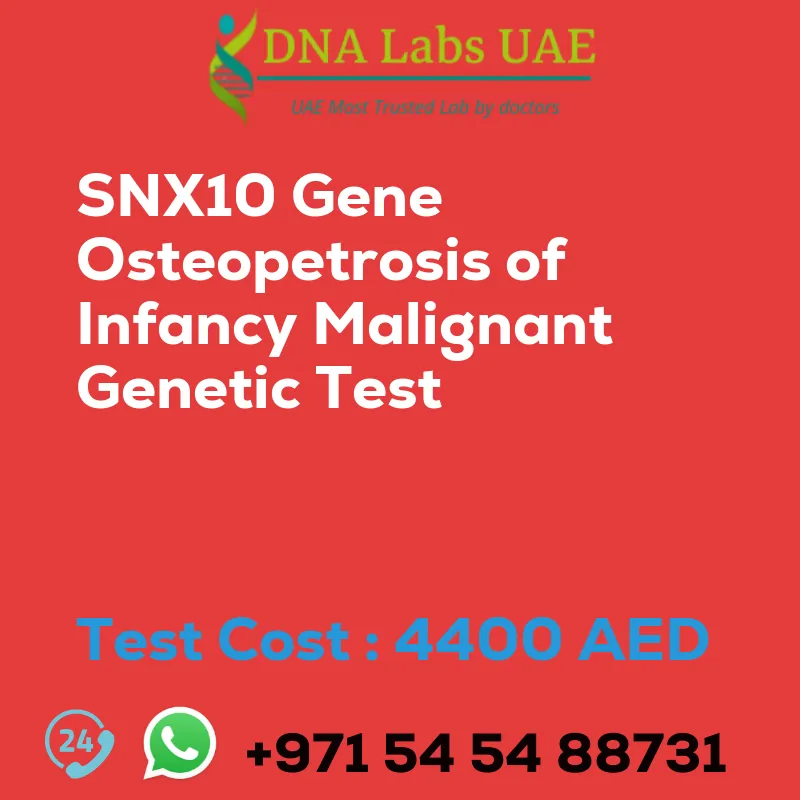SNX10 Gene Osteopetrosis of Infancy Malignant Genetic Test
Welcome to DNA Labs UAE, where we offer the SNX10 Gene Osteopetrosis of Infancy Malignant Genetic Test. This test is designed to detect and diagnose the rare genetic disorder known as osteopetrosis of infancy, malignant type.
Test Details
The SNX10 gene is associated with osteopetrosis of infancy, malignant type, a condition characterized by abnormal bone growth and density. This leads to brittle bones that are prone to fractures. Our Next-Generation Sequencing (NGS) technology allows for the simultaneous analysis of multiple genes, including the SNX10 gene, enabling us to identify specific mutations or variations that may be responsible for osteopetrosis of infancy.
Symptoms and Diagnosis
Osteopetrosis of infancy, malignant type, is the most severe form of the condition and typically presents early in infancy. It can cause a range of symptoms, including failure to thrive, recurrent infections, anemia, vision and hearing problems, and neurological abnormalities. Our genetic test can be useful in confirming a diagnosis and predicting the severity of the condition.
Test Components and Price
Our SNX10 Gene Osteopetrosis of Infancy Malignant Genetic Test is priced at 4400.0 AED. The test can be conducted using blood or extracted DNA, or even a single drop of blood on an FTA card.
Report Delivery and Method
Once the test is conducted, the report will be delivered within 3 to 4 weeks. We utilize NGS technology, which allows for accurate and efficient analysis of the SNX10 gene.
Test Type and Doctor
This genetic test falls under the category of Osteology Dermatology Immunology Disorders. It is recommended to consult with a dermatologist for this particular test.
Test Department
The SNX10 Gene Osteopetrosis of Infancy Malignant Genetic Test is conducted by our Genetics department.
Pre Test Information
Prior to conducting the test, it is important to provide the clinical history of the patient who is going for the SNX10 Gene Osteopetrosis of Infancy Malignant Genetic Test. Additionally, a genetic counseling session will be conducted to draw a pedigree chart of family members affected by SNX10 Gene Osteopetrosis of Infancy, Malignant NGS Genetic DNA Test gene SNX10.
Importance and Benefits
Genetic testing for osteopetrosis can provide valuable information for confirming a diagnosis, predicting the severity of the condition, and assisting in family planning. It can also help guide treatment decisions and management strategies. We recommend consulting with a genetic counselor or healthcare professional specializing in genetics to fully understand the implications of genetic testing and accurately interpret the results.
| Test Name | SNX10 Gene Osteopetrosis of infancy malignant Genetic Test |
|---|---|
| Components | |
| Price | 4400.0 AED |
| Sample Condition | Blood or Extracted DNA or One drop Blood on FTA Card |
| Report Delivery | 3 to 4 Weeks |
| Method | NGS Technology |
| Test type | Osteology Dermatology Immunology Disorders |
| Doctor | Dermatologist |
| Test Department: | Genetics |
| Pre Test Information | Clinical History of Patient who is going for SNX10 Gene Osteopetrosis of infancy, malignant NGS Genetic DNA Test. A Genetic Counselling session to draw a pedigree chart of family members affected with SNX10 Gene Osteopetrosis of infancy, malignant NGS Genetic DNA Test gene SNX10 |
| Test Details |
The SNX10 gene is associated with a rare genetic disorder called osteopetrosis of infancy, malignant type. Osteopetrosis is a condition characterized by abnormal bone growth and density, leading to brittle bones that are prone to fractures. NGS (Next-Generation Sequencing) genetic testing is a type of genetic testing that allows for the simultaneous analysis of multiple genes, including the SNX10 gene. This test can identify specific mutations or variations in the SNX10 gene that may be responsible for osteopetrosis of infancy. The malignant type of osteopetrosis is the most severe form and typically presents early in infancy. It can lead to a range of symptoms, including failure to thrive, recurrent infections, anemia, vision and hearing problems, and neurological abnormalities. Genetic testing for osteopetrosis can be useful for confirming a diagnosis, predicting the severity of the condition, and providing information for family planning purposes. It can also help guide treatment decisions and management strategies. It’s important to consult with a genetic counselor or healthcare professional who specializes in genetics to understand the implications of genetic testing and to interpret the results accurately. They can provide guidance on the best course of action based on the test results and individual circumstances. |








